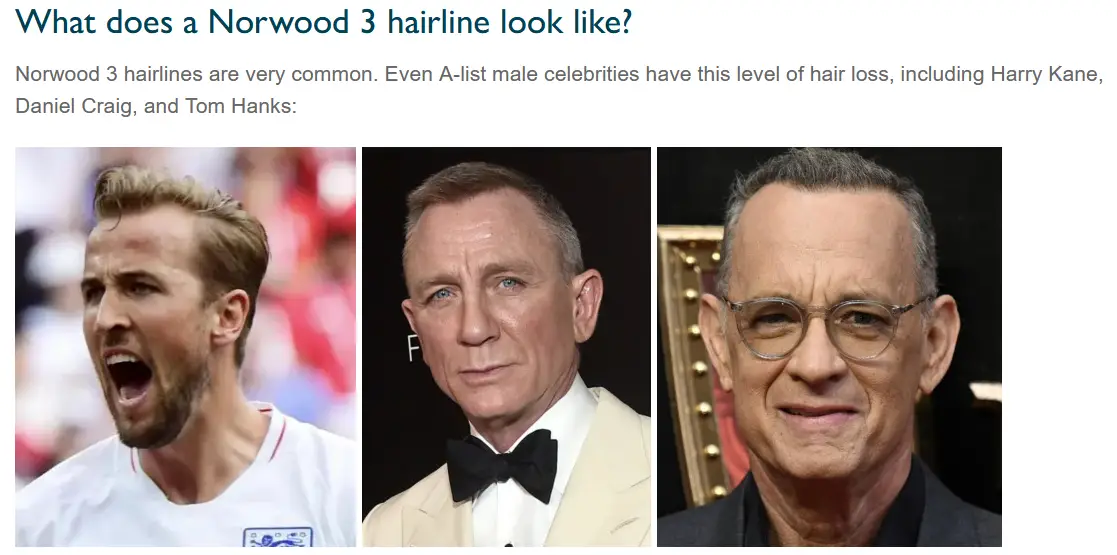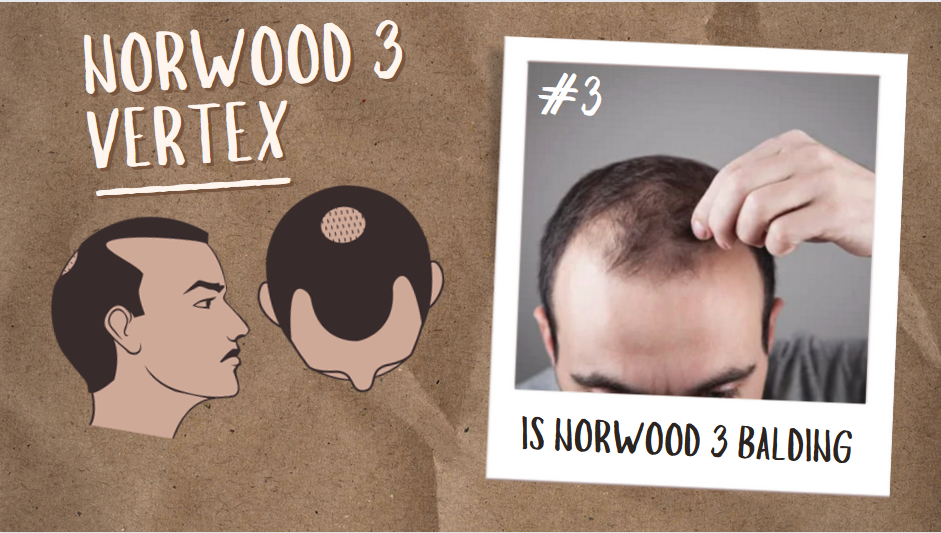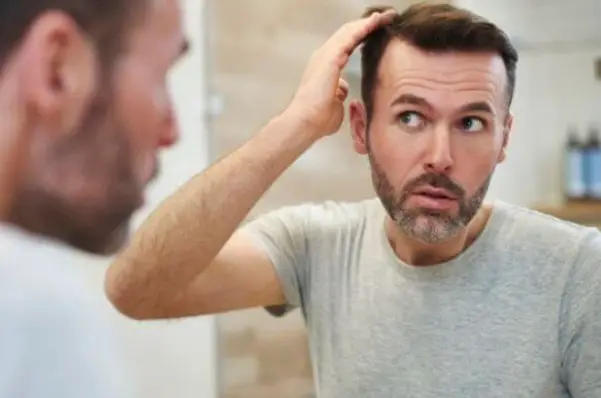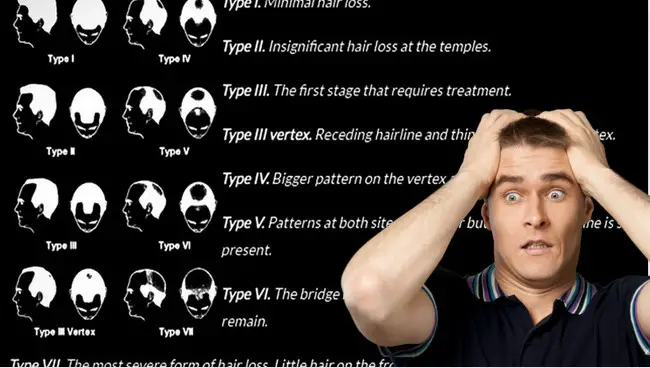Dealing with hair loss can be a daunting experience, especially when you notice it at an early stage. Norwood 3 Vertex is a common phase in male pattern baldness that marks the beginning of visible hair loss around the temples and frontal area of the scalp.
In this informative blog post, we’ll dive into what exactly Norwood 3 Vertex is, explore its causes, and treatment options available to counter it effectively, and discuss preventative measures to maintain healthy hair moving forward. If you’re worried about your receding hairline or curious about understanding how best to cope with hair loss at such an early stage, read on for valuable insights and expert advice tailored just for you.
Understanding Norwood 3 Vertex Hair Loss
Norwood 3 Vertex Hair Loss is an early stage of male pattern baldness that is characterized by visible hair loss at the temples and frontal area of the scalp, with temporal recession deepening in addition to hair loss at the temples.
Definition Of Norwood Scale
The Norwood Scale, also known as the Norwood-Hamilton scale, is a widely recognized classification system for male pattern hair loss. This scale outlines seven stages of baldness, ranging from stage 1 (minimal to no hair loss) to stage 7 (severe hair loss). Developed by Dr. James Hamilton in the 1950s and later revised by Dr. O’Tar Norwood in the 1970s, this scale has become an essential tool for assessing the severity of hair loss and tracking its progression over time.
Understanding one’s location on the Norwood Scale is crucial for determining appropriate treatment options and setting realistic expectations for potential results. In particular, individuals experiencing significant hair loss at stage 3 vertex may wonder if they are actually going bald or simply experiencing a natural change in their hairline. By using this standardized measurement scale, both patients and medical professionals can have a more accurate understanding of each individual’s unique situation—and ultimately make smarter decisions about how to address it.
Is Norwood 3 Balding
Norwood 3 balding signifies the beginning of noticeable hair loss in men, marking a transition from slight to more significant recession at the temples and potentially thinning or balding at the crown (vertex) of the head. According to the Norwood-Hamilton scale, which assesses male pattern hair loss with seven distinct stages, Type III represents the minimal extent of hair loss that can be classified as baldness. This is when a receding hairline becomes more prominent and often combines with a small bald patch on top of the scalp.
While some men may view Norwood 3 vertex as an early stage in their journey toward more advanced stages of male pattern baldness, it’s important not to panic. Many effective treatment options exist for addressing this level of hair loss – ranging from medications like Finasteride and Minoxidil to low-level laser therapy or even hair transplant surgery if deemed necessary by medical professionals. The key in tackling Norwood 3 vertex lies in early detection and proactive action: adopting a healthy lifestyle, avoiding harsh chemical treatments for your hair, maintaining good hygiene habits, and consulting with experts who can recommend a personalized plan based on individual needs.
Norwood 2 Vs 3
In comparing Norwood 2 and Norwood 3 stages of male pattern hair loss (MPHL), it is essential to understand the key differences between these two stages. At the Norwood 2 stage, men typically experience a slight recession of their hairline around the temples, creating an “M” shape on their forehead. While this may be noticeable, it does not necessarily mean that baldness is imminent; rather, it could indicate a need for treatment or closer monitoring.
On the contrary, Norwood 3 vertex represents a more advanced stage of MPHL characterized by significant hair loss. Men with this stage commonly face thinning at both the hairline and crown or vertex area. This visible progression distinguishes it from Norwood 2 as being closer to potential baldness while also emphasizing its importance for taking action through treatments like medication or hair transplant surgery options. In conclusion, understanding the distinction between Norwood 2 and 3 is crucial in determining appropriate measures to tackle ongoing hair loss effectively and proactively manage one’s appearance.
Stages Of Norwood 3 Vertex Hair Loss
Norwood 3 Vertex hair loss has several stages, which can be identified using the Norwood Scale.
Here are the stages:
1. Stage 3A: Hair begins to recede from the front and temporal regions of the scalp.
2. Stage 3V: The hairline continues to recede, and a bald spot starts to appear at the crown or vertex of the head.
3. Stage 3AV: Both stage 3A and stage 3V occur simultaneously, resulting in a horseshoe-shaped pattern of hair loss.
It’s important to note that not everyone will experience all stages of Norwood 3 Vertex hair loss, and the progression may vary from person to person. However, early detection of your receding hairline stages can help in preventing further hair loss and implementing effective treatment options.
Signs And Variations Of Norwood 3 Vertex Hair Loss
Norwood 3 Vertex hair loss is characterized by significant thinning of hair on the crown or vertex of the scalp. In this stage, a bald spot may start to appear at the top-back portion of your head. As for variations, some men may experience a slow progression towards Norwood 3 Vertex while others will notice abrupt hair loss in this area. Additionally, not all men will have an identical pattern of baldness in Stage 3 Vertex; some may have more sparse coverage than others.
It’s important to note that Norwood 3 Vertex does not always mean complete baldness in this area. Some men can still retain a reasonable amount of hair on their crowns while dealing with severe thinning and receding patterns around their temples and frontal areas concurrently. Regardless of the pattern or severity, if you suspect any signs of hair loss on your crown or vertex region, it’s wise to consult with a specialist right away to discuss available treatment options such as topical finasteride or Hair Transplant Surgery depending on the specific case buildup and condition diagnosed by a professional expert so as to regain confidence and self-esteem about looks once again.

Causes Of Norwood 3 Vertex Hair Loss
Norwood 3 Vertex hair loss is primarily caused by genetics and hormonal imbalances, specifically the sensitivity of hair follicles to dihydrotestosterone (DHT), a hormone that causes miniaturization and eventual death of hair follicles. Other factors like stress, poor nutrition, medical conditions such as thyroid disorders, and certain medications can also contribute to hair loss. Additionally, lifestyle choices such as smoking or excessive alcohol consumption may accelerate the progression of Norwood 3 vertex hair loss. It’s essential to identify and address the underlying cause(s) through consultation with a medical professional before choosing an appropriate treatment option.
Treatment Options For Norwood 3 Vertex Hair Loss
Hair transplant surgery, medications like finasteride and minoxidil, and low-level laser therapy are all effective treatment options for Norwood 3 Vertex hair loss.
Keep reading to learn more about these treatments and what you should consider before making a decision.
Hair Transplant Surgery
Hair transplant surgery is a popular treatment option for Norwood 3 Vertex hair loss. It involves extracting hair follicles from the back of the scalp and transplanting them to areas experiencing significant hair loss at the vertex stage. Hairpalace, Europe’s leading clinic, offers a free consultation with Dr. Ljuba Zsolnai to assess whether you would be a suitable candidate for this procedure.
During an FUE (Follicular Unit Extraction) procedure, individual grafts containing one to four hairs are extracted using special instruments and transplanted into tiny incisions in the scalp. The result is natural-looking hair growth that can last a lifetime. With over 13 years of experience and more than 10,000 successful surgeries under their belt, Hairpalace is well-equipped to provide top-quality care for those experiencing Norwood 3 Vertex hair loss.
Medications Such As Finasteride
Finasteride is a medication that has been shown to effectively treat vertex hair loss in patients with androgenetic alopecia. Available in both topical and oral forms, it works by blocking the conversion of testosterone to dihydrotestosterone (DHT), which is believed to contribute to hair loss. A randomized controlled study found that after six months of treatment with finasteride, patients reported a decrease in hair fall and the appearance of new hair.
Minoxidil (Topical Finasteride and Minoxidil Gel ) is another medication commonly used for treating hair loss that might be effective as part of your norwood 3 vertex treatment plan. However, studies have produced mixed results when comparing its efficacy to finasteride’s. Minoxidil works by widening blood vessels, allowing more oxygen, blood flow, and nutrients to reach the follicles. Like finasteride, this drug can be taken orally or applied topically directly onto the scalp where there are signs of baldness or thinning hair patches.
Low-Level Laser Therapy
Low-Level Laser Therapy (LLLT) is a popular treatment option for Norwood 3 Vertex hair loss. It has been reported to restore hair follicles and increase energy and blood flow to the scalp, resulting in improved hair growth. Some of the notable brands that offer LLLT devices for hair loss treatment include:
- kiierr laser cap
- Irestore professional 282 laser hair helmet
- Illumiflow 272 pro laser cap
A sham device-controlled trial suggested that the Oaze helmet-type 3R LLLT device was very effective in increasing terminal hair growth. The effectiveness and cost of LLLT for hair loss treatment vary depending on the brand and device. For instance, some devices may require daily usage for optimal results while others may only require weekly use. Additionally, some brands offer affordable options while others are more expensive but offer superior quality technology.
In conclusion, Low-Level Laser Therapy is an innovative treatment option that can help manage Norwood 3 Vertex Hair Loss. If you’re considering this type of therapy, it’s important to do your research and choose a reputable brand with proven success rates like Kiierr, Irestore or Illumiflow based on your budget and preferences.
Expected Results And Considerations For Each Treatment
It is essential for those experiencing Norwood 3 Vertex hair loss to weigh the expected results and considerations of each treatment option to make an informed decision. The table below outlines the potential outcomes and factors to consider for various treatments targeting Norwood 3 Vertex hair loss.
| Treatment Option | Expected Results | Considerations |
|---|---|---|
| Hair Transplant Surgery | Permanent, natural-looking hair restoration and increased coverage in the affected area. | Cost, recovery time, and potential complications from surgery. |
| Medications (Finasteride, Topical Minoxidil) | Slowed hair loss progression and potential regrowth of lost hair. | Possible side effects, long-term usage, and effectiveness may vary among individuals. |
| Low-Level Laser Therapy (Kiierr, iRestore, Illumiflow) | Increased hair density and growth, particularly effective for early-stage hair loss. | Initial cost of device, consistency in usage is required, and effectiveness may vary. |
| Hair Loss Prevention Products | Maintain existing hair health and potentially slow down hair loss progression. | Effectiveness varies, ongoing usage required, and potential product-specific side effects. |
Evaluating the expected results and considerations of each treatment option will help ensure that individuals with Norwood 3 Vertex hair loss find the most suitable solution for their specific situation.
Preventing And Managing Norwood 3 Vertex Hair Loss
Adopting a healthy lifestyle, avoiding harsh hair treatments, practicing good hair hygiene, and considering hair loss prevention products are effective methods for preventing and managing Norwood 3 Vertex hair loss.
Adopting A Healthy Lifestyle
Taking care of your overall health can contribute significantly to preventing and managing Norwood 3 Vertex hair loss. Eating a well-balanced diet rich in vitamins and minerals, such as iron, zinc, biotin, and protein, can help promote healthy hair growth. Incorporating regular exercise into your routine improves circulation and helps deliver nutrients to the scalp.
Another important aspect is avoiding harsh hair treatments that can cause damage to the follicles or lead to breakage. This includes avoiding chemical treatments like relaxers or frequent heat styling tools like flat irons or curling wands. Practicing good hair hygiene by washing your scalp regularly with gentle shampoos also promotes a healthy environment for hair growth. Finally, considering hair loss prevention products formulated with natural ingredients may be helpful in slowing down the progression of thinning hair on the vertex.
Remember that taking care of yourself not only benefits your physical health but also contributes positively towards maintaining a full head of healthy-looking hair!
Avoiding Harsh Hair Treatments
To prevent and manage Norwood 3 Vertex Hair Loss, it’s crucial to adopt a holistic approach to hair care. One important aspect of this is avoiding harsh hair treatments that can damage your scalp and weaken your hair follicles. These include chemical treatments like perms, relaxers, or bleaching agents that can strip away natural oils from the scalp and lead to dryness and breakage. Heat styling tools like flat irons or curling wands can also cause significant damage if used excessively or at high temperatures.
Instead, you should opt for gentler alternatives like sulfate-free shampoos and conditioners that are formulated specifically for thinning hair. Natural remedies like coconut oil or aloe vera gel can help soothe inflammation on the scalp while promoting healthy hair growth. It’s also essential to avoid tight hairstyles that pull on your roots, causing tension alopecia over time. Examples of such styles include braids, weaves, tight ponytails or buns.
In summary, adopting gentle yet effective hairstyling techniques is critical if you want to prevent further thinning of your scalp due to Norwood 3 Vertex Hair Loss. Be sure to seek advice from trusted dermatologists who specialize in treating male pattern baldness so they may guide you towards the best practices suitable for improving the overall quality of both your existing as well as new strands of hair growth over time with proper treatment options such as medication or transplant surgery where appropriate.
Practicing Good Hair Hygiene
Practicing good hair hygiene is essential for preventing and managing Norwood 3 Vertex hair loss. It involves washing your hair regularly with a mild shampoo to remove dirt, oil, and other impurities that can clog the hair follicles and inhibit healthy hair growth. You should also avoid using harsh chemicals such as dyes or bleach on your hair, as these can damage the scalp and weaken the hair strands.
In addition to regular washing, it’s important to use a wide-toothed comb or brush when styling your hair to prevent tugging or pulling at the roots. Wetting your hair before brushing can also help reduce breakage. Finally, be sure to protect your scalp from prolonged exposure to sunlight by wearing a hat outdoors during peak hours of sun intensity. By following these simple tips for good hygiene practices, you can help keep Norwood 3 Vertex balding at bay and promote healthier-looking locks overall.
Did you know that poor hygiene habits like infrequent shampooing or overuse of styling products can contribute significantly in thinning out existing hairs? When practiced together with proper care routines that involve massaging oils into your scalp and eating healthily; maintaining good hygiene becomes one of many ways through which you could slow down male pattern baldness rate.
Considering Hair Loss Prevention Products
One effective way to prevent and manage Norwood 3 Vertex hair loss is by using hair loss prevention products. These can include shampoos, conditioners, and other topical treatments that contain ingredients like minoxidil or biotin. Minoxidil is an FDA-approved ingredient that has been shown to stimulate hair growth in some people, while biotin is a B-vitamin that helps keep the scalp healthy and promotes stronger hair.
Other popular preventative measures include supplements such as Viviscal or Nutrafol. These products contain natural ingredients like saw palmetto extract, marine collagen, and ashwagandha root which have been clinically proven to help prevent hair loss.
It’s important to note that not all prevention products work for everyone and keeping realistic expectations is crucial when trying them out. It’s also essential to make sure you’re taking care of your overall health since poor nutrition can lead to nutrient deficiencies causing further thinning of the hair.
Norwood 3 Vertex Hair Transplant
Norwood 3 Vertex hair transplant involves determining the number of grafts required for your specific case, and examples of successful results can inspire those considering this route. Keep reading to learn more about Norwood 3 Vertex hair loss treatment options and prevention strategies.
Determining The Number Of Grafts Required
The number of hair grafts required for a Norwood 3 vertex hair transplant varies based on the extent and pattern of hair loss. On average, patients with this stage require between 1000-1400 grafts. However, this can differ substantially depending on individual factors such as age, sex, and genetics.
The Hamilton-Norwood classification system is used to determine the stage of male pattern baldness and provide an estimate for the number of grafts needed for treatment. During a consultation with a qualified doctor or surgeon, they will examine your scalp’s condition and recommend the best approach for achieving natural-looking results. It’s important to note that more extensive cases may require several treatments spread over time to ensure optimal coverage and thickness in areas affected by significant hair loss at Norwood Stage 3 Vertex..
Examples Of Norwood 3 Vertex Hair Transplant
Hair transplant surgery is one of the most effective treatments for Norwood 3 Vertex hair loss. The procedure involves extracting hair follicles from the donor area and transplanting them to the recipient area on top of the head. Depending on the patient’s unique needs, anywhere from 1,500 to 3,000 grafts may be required to achieve optimal results. Patients can view examples of past Norwood 3 Vertex hair transplant procedures online or through consultations with a qualified doctor to get an idea of what kind of results they can expect.
It’s important to note that not all patients will achieve identical results following a Norwood 3 Vertex hair transplant. Factors such as age, degree of hair loss, and type of hair texture play significant roles in determining success rates. Therefore, it’s crucial for patients to undergo thorough consultations with their physician before considering any form of treatment. Ultimately, however, a successful Norwood 3 Vertex hair transplant can significantly improve self-confidence and aesthetic appearance for those who are experiencing baldness at this stage.
Cost Of Hair Transplant
Hair transplant cost varies depending on the number of grafts needed to cover the bald or thinning areas. For Norwood 3 hair loss, around 1500-2000 grafts may be required. The procedure’s total expense can range from $6000 to $12000 based on factors like location, surgeon experience, and clinic reputation.
It’s important to note that the cheapest option isn’t always the best one; selecting an experienced and reputable surgeon is crucial for a successful outcome. It’s also worth considering any special offers or promotions offered by clinics, such as discounts on larger procedures like 2700+ grafts at just $3.99 per graft before March 31st, 2023 with our partner Hairpalace Clinic in Europe’s Leading clinics.
Overall, while hair transplant surgery can be expensive upfront, it’s a worthwhile investment in restoring confidence and helping individuals feel comfortable in their skin again. With proper care and maintenance after the procedure (and within months seeing brand-new hair growing), patients can look forward to long-lasting results that boost their self-image and take years off their appearance.
Medical Treatment For Norwood 3 Vertex Hair Loss
One of the medical treatments for Norwood 3 Vertex hair loss is finasteride, a medication that can minimize hair loss by blocking the production of dihydrotestosterone (DHT), a hormone that contributes to male pattern baldness; read on to learn more about available treatments and how to prevent further hair loss.
Finasteride Usage And Benefits
Finasteride is a medication used to treat male pattern baldness or androgenic alopecia (AGA) in men and women. It works by blocking the conversion of testosterone into dihydrotestosterone, which is responsible for hair loss. Oral Finasteride 1 mg has been found to slow down hair loss progression or trigger enhanced hair growth compared to placebo, according to long-term studies. This therapy leads to significant cosmetic improvements for patients as it increases scalp hair count.
The FDA has approved finasteride usage for mild-to-moderate male pattern baldness in the midfrontal area of patients aged 18-41 years old. However, there are no available long-term Japanese studies on AGA treatment with finasteride that last up to ten years yet. While these findings suggest that finasteride can be helpful in combating AGA-related hair loss effectively, it’s important always to consult your physician before starting any new medication regimen.
FAQs: Norwood 3 Vertex
Are you curious about whether Norwood 3 Vertex hair loss is treatable? Or, are you wondering how to prevent and manage hair loss? Browse our FAQ section for answers to all your questions.
Can Norwood 3 Vertex Hair Loss Be Reversed?
Norwood 3 Vertex Hair Loss is characterized by balding on the vertex or crown of the head, and it is considered a moderate stage of male pattern baldness. Unfortunately, there’s no cure for this type of hair loss. However, there are treatments available that can slow down its progression and in some cases can even stimulate hair regrowth. One such treatment is Finasteride which reduces DHT levels, the hormone responsible for causing hair follicles to shrink in size and eventually stop producing new hairs. Topical finasteride and minoxidil may also be used to promote hair growth and reduce further thinning.
Hair transplant surgery is another option if you’re looking to restore lost hair from Norwood 3 Vertex Hair Loss permanently. The procedure involves transplanting healthy hair from one area of your scalp (usually the sides or back) to the affected area using grafts. It’s essential to note that early detection and treatment of Norwood 3 Vertex Hair Loss could play a pivotal role in restoring lost hairs successfully because when too much time passes, surgical restoration might not guarantee enough coverage for significant areas with Hair transplant alone as many grafts are needed depending on how long the condition has gone untreated.
Is Norwood 3 Vertex Hair Loss Treatable?
Yes, Norwood 3 Vertex hair loss is treatable. There are several treatment options available including hair transplant surgery, medications such as Finasteride, low-level laser therapy, and adopting a healthy lifestyle to prevent and manage hair loss. Hair transplant surgery can provide permanent results with natural-looking hair growth by extracting healthy follicles from the back of the scalp and grafting them onto the affected area.
Medications like Finasteride have been proven effective in preventing further hair loss by blocking DHT hormone production that affects hair growth. Low-level laser therapy devices like Kiierr, iRestore, and Illumiflow can also stimulate follicle stimulation leading to regrowth.
It’s important to note that early detection and treatment play a significant role in achieving successful outcomes for Norwood 3 Vertex hair loss. Seeking clinical diagnosis from experienced surgeons or medical professionals is recommended before deciding on any treatment options.
How To Fix Vertex Baldness?
If you’re experiencing Norwood 3 vertex hair loss, there are several treatment options available to fix this issue. One of the most effective treatments for fixing vertex balding is a hair transplant surgery. During this procedure, healthy hair grafts are taken from other areas of your scalp and transplanted onto the balding area on your vertex. The number of grafts needed will depend on the severity of your hair loss.
Another option for treating Norwood 3 vertex baldness is medication such as Finasteride or topical minoxidil. These medications can help slow down or even stop further hair loss in some cases. However, they may not be as effective at regrowing lost hair like a hair transplant.
It’s important to note that while these treatments can help fix vertex baldness, they cannot reverse any Norwood stage completely. So it’s best to seek treatment early before significant damage has been done to your scalp and remaining follicles.
Is Norwood 3 Vertex A Mature Hairline?
Many people consider Norwood 3 Vertex to be a “mature hairline” because it is a common stage of hair loss that many men experience as they age. However, it’s important to note that not all cases of Norwood 3 are the same. While some may only experience slight recession at the temples, others may have significant thinning at the crown or top of their head.
It’s also worth noting that just because someone has a mature hairline does not necessarily mean they will go bald. In fact, it is possible for those with a mature hairline to still have thick and healthy hair on the rest of their head. That being said, if you’re experiencing unusual hair loss or thinning beyond what’s considered normal for your age, it’s always recommended to speak with a doctor or dermatologist to determine any underlying causes and potential treatment options.
Hair Transplant Options For Norwood 3 Vertex
If you’re experiencing hair loss at the Norwood 3 Vertex stage, there are several options available to you, including:
1. Follicular Unit Transplantation (FUT) – This procedure involves removing a strip of hair-bearing scalp from the back of the head and dissecting it into individual units for transplantation. The hair follicles are then transplanted into the balding areas of the scalp.
2. Follicular Unit Extraction (FUE) – This method involves extracting individual hair follicles from the scalp using a specialized device, such as NeoGraft or ARTAS. This option allows for minimal scarring and quicker recovery time.
3. Direct Hair Implantation (DHI) – This technique is similar to FUE but involves implanting the follicles directly into the recipient area immediately after extraction, which may lead to higher graft survival rates.
4. Robotic Hair Restoration – Using advanced robotics technology, this method involves creating a detailed 3D map of your scalp to determine where follicles should be placed with precision.
Consulting with a qualified hair transplant surgeon can help you determine which hair transplant option is best suited for your specific needs based on factors such as your age, overall health, extent of hair loss and desired results.
Conclusion: Addressing Norwood 3 Vertex Hair Loss
In conclusion, early detection and treatment of Norwood 3 Vertex hair loss is crucial for effective management. With a variety of treatment options available, such as hair transplant surgery and medications like finasteride, patients can regain their confidence and healthy-looking hair. Take steps to prevent further balding by adopting a healthy lifestyle, practicing good hair hygiene, and considering hair loss prevention products. To learn more about addressing Norwood 3 Vertex Hair Loss and other stages of male pattern baldness, continue reading our informative blogs.
Importance Of Early Detection And Treatment
Norwood 3 Vertex Hair Loss is a gradual process that can lead to significant hair thinning and balding at the crown or vertex. Early detection and treatment of Norwood 3 Vertex hair loss are important to prevent further progression. If left untreated, the condition may worsen, resulting in more extensive baldness, which can be difficult to reverse.
Treatment options for Norwood 3 Vertex Hair Loss are more effective when started early. Therefore, it’s recommended that individuals who notice signs of thinning or receding areas on their scalp should seek medical attention as soon as possible. With timely care from a qualified healthcare professional or dermatologist, managing and treating Norwood 3 Vertex hair loss is achievable through various interventions like medication, therapy or even surgery using scalp micro-pigmentation (SMP) or a hair transplant procedure.
Effective Methods To Prevent And Manage Hair Loss.
Preventing hair loss is easier than treating it after it has already begun. Adopting a healthy lifestyle, avoiding harsh hair treatment, and practising good hair hygiene can slow down the progression of hair loss. A balanced diet rich in iron, zinc, biotin, vitamin D, and protein can be especially helpful in promoting healthy hair growth.
Another way to prevent or manage Norwood 3 vertex hair loss is by considering the use of specialized products. Shampoos that contain caffeine and ketoconazole may help stimulate follicle activity and curb inflammation respectively. Phytochemicals found in plants like saw palmetto extract and pumpkin seed oil have also shown potential as natural remedies for thinning hair. By taking a proactive approach to your grooming routine through these effective methods, you can keep hairs where they belong – on your head!
Source URLs
- https://www.ncbi.nlm.nih.gov/pmc/articles/PMC9298335/
- https://www.healthline.com/health/norwood-scale
- https://my.clevelandclinic.org/health/diseases/21753-hair-loss
- https://onlinelibrary.wiley.com/doi/full/10.1111/ics.12554
- https://www.ncbi.nlm.nih.gov/pmc/articles/PMC4812885/
- AI Powered Bald Filter Online 2024: See Yourself with No Hair! - January 19, 2024
- Harklinikken Bad Reviews 2024: Analyzing Negative Feedbacks - January 18, 2024
- How to Get the Alex Eubank Hair | Step-By-Step Tutorial 2024 - January 18, 2024







